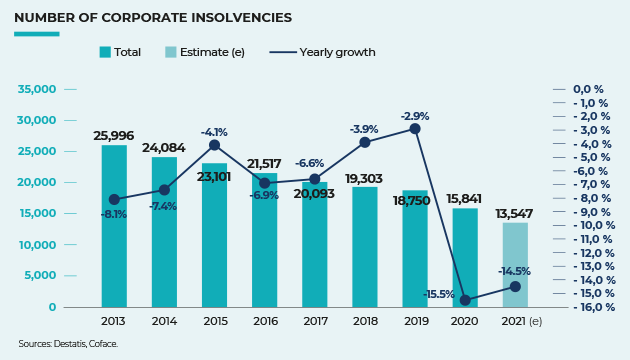

Germany
Synthesis
major macro economic indicators
| 2020 | 2021 | 2022 | 2023 (e) | 2024 (f) | |
|---|---|---|---|---|---|
| GDP growth (%) | -3.7 | 3.2 | 1.8 | -0.3 | 0.6 |
| Inflation (yearly average, %) | 0.5 | 3.1 | 6.9 | 5.9 | 3.1 |
| Budget balance (% GDP) | -4.3 | -3.7 | -2.7 | -1.7 | -0.6 |
| Current account balance (% GDP) | 7.1 | 7.7 | 4.2 | 5.7 | 6.2 |
| Public debt (% GDP) | 68.0 | 69.3 | 66.2 | 64.0 | 62.7 |
(e): Estimate (f): Forecast
STRENGTHS
- Strong industrial base (23% of GDP in 2022)
- Low structural unemployment; well-developed apprenticeship system
- Importance of family-owned exporting SMEs (Mittelstand)
- Consensus-orientated politics, institutional system promoting representativeness
WEAKNESSES
- Declining working population from 2020 onwards, despite immigration
- Strong dependence on international energy imports (share of net imports in domestic consumption was 64% in 2021)
- Economy’s heavy dependence on foreign trade, which is mainly focused on single countries like China
- Prominence of the automotive and mechanical industries, particularly in exports (29% of total exports in 2022)
- Capacity constraints, insufficient investment (especially in internet accessibility) and venture capital limits productivity gains
Risk assessment
German economy to recover slightly after recession
After a minor recession in 2023, the German economy is set for a mild recovery in 2024. This recovery will be driven by stronger growth in the domestic consumer services sector, while the outlook for the manufacturing sector is highly dependent on demand from abroad. Although supply chain issues still outweigh the long-term average, they have decreased noticeably over 2023 and should only have a limited impact on production in 2024. In addition, Germany is not expected to face another energy crisis over the winter of 2023-2024 like the one the year before. Natural gas imports declined over the summer of 2023, notably from the Netherlands and Belgium. Due to a change in consumption behaviour and already high gas storage levels (85% in mid-July 2023 compared to 65% in July 2022), the probability of energy scarcity in the winter is lower. However, foreign demand for German products (representing 40% of GDP) is lower than in pre-pandemic times, especially as China has not recovered as fast as expected in 2023. Exports to China, in real terms, were, on average 22% lower in the first half of 2023 than during the equivalent pre-pandemic period of 2019. A similar trend materialised with the second- and third-biggest export partners – France and the Netherlands, respectively – while at least trade with the US (Germany’s largest export partner) normalised. The trend is partly driven by low general demand in Europe and should reverse in 2024; however, some of it, especially demand from China, is due to a structural change in trade relationships and the fact that China is now producing some of the products that they previously imported from Germany, e.g., in the machinery, chemicals and auto parts segments).
On the demand side, the recovery should emanate from personal consumption (52% of GDP), which is likely in part to normalise in 2024 after decreasing in 2022-2023. The main reason is the wage increases which resulted from the collective bargaining agreements struck in early 2023. Average wages should increase between 2% and 5.5% in January 2024, after already increasing in 2023 by an average of 4% to 5% (and/or a €3,000 one-off inflation subsidy). The lack of skilled workers and the durably low level of unemployment have given the unions greater negotiating clout. The government will also raise the minimum wage by 3.4% in January 2024 after a 14.8% increase in the autumn of 2022.The wage adjustment will, in part, level out the purchasing power losses resulting from inflation over the last two years. However, the electricity and gas price caps will be terminated in January 2024 (but an extension until April 2024 is currently under discussion). In addition, the CO²-emission price will increase from €30 per tonne to €35, resulting in a €166 price hike in the regular household heating bill. Taken together, all these measures will feed into inflation. However, as the rise in energy prices is lower than in 2023, the yearly inflation rate should nonetheless decrease further in 2024 and stabilise at around 3%. The core inflation rate excluding energy and fresh food should remain above headline inflation. Until July 2023 and in four successive moves the European Central Bank (ECB) increased its key interest rate by a total of 175 basis points in 2023 to 4.25% for its marginal lending rate, pushing it up to one of the highest interest rate levels in its history. With European inflation being on a downtrend, the ECB should go into “wait-and-see” mode. The first rate cuts are unlikely to occur before mid-2024. In terms of quantitative easing, the ECB already stopped the reinvestments of the APP program in July 2023. The maturing papers as part of the Pandemic Emergency Purchase Program (PEPP) are reinvested fully until at least the end of 2024. Due to the very high interest rate level and the very slow decrease in house prices, construction activity is expected to contract further, while other corporate investments should only post a timid increase. At the same time, government expenditures should further decrease.
Five consecutive years of public deficit
In the wake of the energy crisis, the German government implemented several measures to support private households and companies. Some of the measures, such as the gas and energy price cap, have been less costly than anticipated in 2023 due to falling energy prices. In 2024, all of these measures will be terminated while the higher CO² emission prices will increase revenues. This will lower the public deficit further, but not enough to cause the public budget to swing to a surplus. Nevertheless, even with higher financing costs, public debt as a share of nominal GDP should decrease due to higher nominal GDP.
Germany’s current account surplus should recover further due to an improvement in the terms of trade, together with gradual increases in export volumes and falling import volumes. Trade in the balance of goods will likely be higher in 2024 than during the pandemic years. The structural deficit of trade in the balance of services should widen as more Germans spend their holidays abroad, while the surplus of the investment income balance and the balance of current transfers (deficit) should see only small changes. Moreover, with strong growth in nominal GDP, the current account balance as a share of nominal GDP should be lower than in pre-pandemic times.
The first three-party-governing coalition in German history is (still) muddling through
Since December 2021, German Chancellor Olaf Scholz (Social Democrat, SPD) has led the very first three-party coalition in German history with the SPD (206 out of 736 seats in Parliament), the environmentalist Greens (118 seats) and the liberal FDP (92 seats). The war in Ukraine and the resulting energy crisis have caused a drift towards the centre, especially for the parties on the outer edge, i.e., the Greens and the FDP. The political work of the coalition is characterised by large-scale public infighting between parties around legislative projects that were leaked. The Greens had to soften the draft Building Energy Act after fierce opposition from the public. The outcry arose from part of the legislation which ordered that every newly installed heating system is to be operated using 65% renewable energies from 1 January 2024. The FDP, on the other hand, has been publicly criticised for the harsh austerity measures implemented by the finance ministry it directs. The SPD and Chancellor Olaf Scholz rarely interfere in the disputes in a meaningful manner. The main beneficiary of the political turmoil is the national conservative AfD party, which in July 2023 snaffled 20% of the vote in nationwide polls for the first time in its existence. This would make it the second-largest party in the Bundestag behind the conservative CDU/CSU. So far, all other parties in the Bundestag have ruled out any cooperation with the AfD. The latter’s stronger position therefore means that any tie up must include at least three parties to form a majority coalition. With this prospect in mind, it is unlikely that any of the other parties would risk a snap election. The current governing coalition is therefore likely to remain in place until the next scheduled election in September 2025.
Last updated: September 2023
Payment
Bank transfer (Überweisung) remains the most common, means of payment. All leading German banks are connected to the SWIFT network, which enables them to provide a quick and efficient funds transfer service. The SEPA Direct Debit Core Scheme and the SEPA Direct Debit B2B are the newest forms of direct debit.
Bills of exchange and cheques are not used very widely in Germany as payment instruments. For Germans, a bill of exchange implies a critical financial position or distrust in the supplier. Cheques are not considered as payment as such, but as a “payment attempt”: as German law ignores the principle of certified cheques, the issuer may cancel payment at any time and on any grounds. In addition, banks are able to reject payments when the issuing account contains insufficient funds. Bounced cheques are fairly common. As a general rule, bills of exchange and cheques are not considered as effective payment instruments, even though they entitle creditors to access a “fast track” procedure for debt collection in case of non-payment.
Debt Collection
Amicable Phase
The amicable collection is an essential step to the success of collection management. The collection process generally begins with the debtor being sent a final demand for payment, via ordinary or registered mail, reminding the debtor of their payment obligations.
According to the law for the acceleration of due payments (Gesetz zur Beschleunigung fälliger Zahlungen) a debtor is deemed to be in default if a debt remains unpaid within 30 days of the due payment date and after receipt of an invoice or equivalent request for payment, unless the parties have agreed to a different payment period in the purchase contract. In addition, the debtor is liable for default interest and reminder fees upon expiry of this period.
Debt collection is recommendable and common practice in Germany.
Legal proceedings
Fast-track proceeding
Provided the claim is undisputed, the creditor may seek order to pay (Mahnbescheid) through a simplified and cost-efficient procedure. The creditor describes the details of their claim and is subsequently able to obtain a writ of execution fairly quickly via the Online-Dunning Service (Mahnportal), direct interfaces or (only for private individuals) pre-printed forms. Such automated and centralised (for each Bundesland, federal state) procedures are available all over Germany.
This type of action falls within the competence of the local court (Amtsgericht) for the region in which the applicant’s residence or business is located. For foreign creditors, the competent court is the Amtsgericht Wedding (in Berlin). Legal representation is not mandatory.
The debtor is given two weeks after notification to pay their debts or to contest the payment order (Widerspruch). If the debtor does not object within this timeframe, the creditor can apply for a writ of execution (Vollstreckungsbescheid).
Ordinary proceedings
During ordinary proceedings, the court may instruct the parties or their lawyers to substantiate their claim, which the court alone is then authorised to assess. Each litigant is also requested to submit a pleading memorandum outlining their expectations, within the specified time limit.
Once the claim has been properly examined, a public hearing is held at which the court passes an informed judgement (begründetes Urteil).
The losing party will customarily bear all court costs, including the lawyer’s fees of the winning party to the extent that those fees are in conformity with the Official Fees Schedule (the Rechtanwaltsvergütungsgesetz, RVG). In the case of partial success, fees and expenses are borne by each party on a pro rata basis.
Ordinary proceedings can take from three months to a year, while claims brought to the federal Supreme Court can reach up to six years.
An appeal (Berufung) may be brought against the decision of the Court of First Instance if the objected amount in dispute exceeds €600. An appeal will also be admitted by the Court of First Instance if a case involves a question of principle or necessitates revision of the law in order to ensure “consistent jurisprudence”.
Enforcement of a Legal Decision
Enforcement may commence once a final judgement is made. If debtors fail to respect a judgment, their bank accounts may be closed and/or a local bailiff can proceed with the seizure and sale of their property.
For foreign awards, in order to obtain an exequatur, the creditor needs a notarised German translation of the decision which also has to be recognised, an enforcement order of this judgment, and an execution clause. Judgments of courts of EU member states are recognised without further procedure – unless certain restrictions arising from European law are applicable.
Insolvency Proceedings
Out-of Court proceedings
Debtors may attempt to renegotiate their debts with their creditors, which helps to protect debtors from early payment requests. However, the procedure is in the creditors’ interest as it can be faster and tends to be less expensive than formal insolvency.
Restructuring
Following a petition filed before insolvency court on the basis of illiquidity or over-indebtedness, the court may open preliminary insolvency proceedings, where it appoints a preliminary administration aimed at exploring the chances of restructuring the company. If the administration authorizes this restructuration, it then initiates formal proceedings and nominates an administrator in charge of continuing the debtor’s business whilst preserving its assets.
Liquidation
Liquidation may be initiated upon demand of either the debtor or the creditor provided that the debtor is unable to settle its debts as they fall due. Once recognized through a liquidation decision and once the company has been removed from the register, the creditors must file their claims with the liquidation administrator within three months of the publication.
Retention of title
This is a written clause in the contract in which the supplier will retain the ownership over the delivered goods until the buyer has made full payment of the price. There are three versions of this retention:
- simple retention: the supplier will retain the ownership over the goods supplied until full payment is made by the buyer;
- expanded retention: the retention is expended to further sale of the subsequent goods; the buyer will assign to the initial supplier the claims issued form the resale to a third party;
- extended retention: the retention is extended to the goods processed into a new product and the initial supplier remains the owner or the co-owner up to the value of his delivery.




